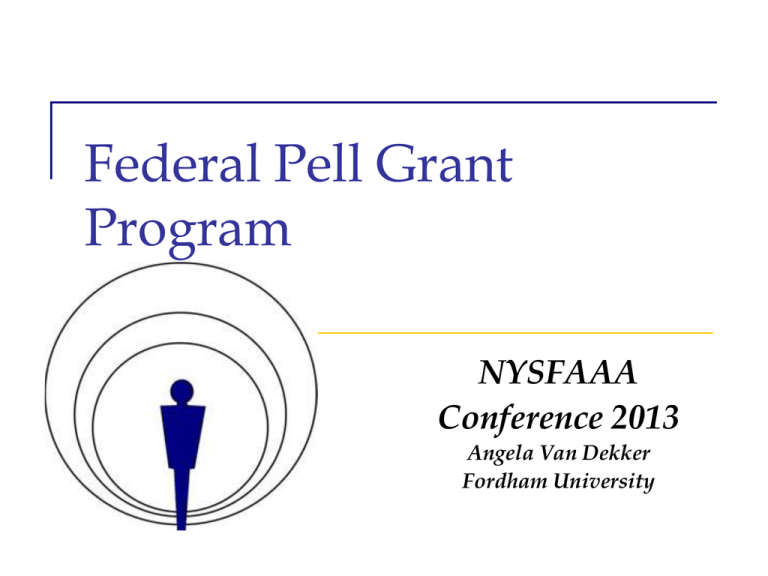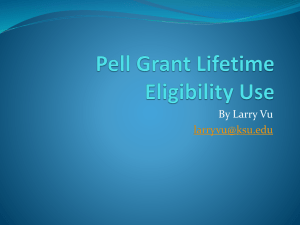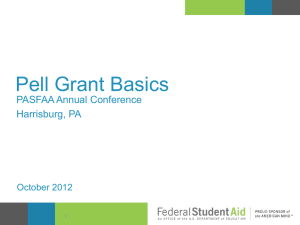FederalPellGrantProg..
advertisement

Federal Pell Grant Program NYSFAAA Conference 2013 Angela Van Dekker Fordham University Introduction Authorized in 1972 as part of the Higher Education Act of 1965. Originally called Basic Educational Opportunity Grant (BEOG). Name change to Pell Grant in honor of Senator Claiborne Pell in 1980. Quasi-entitlement program Eligible student is entitled to the funds whether or not funds remain in the budget Shortfall in budget could result in prorated awards October 2013 NYSFAAA Conference 2013 2 Introduction cont’d Awards are based on EFC (Expected Family Contribution) and COA (Cost of Attendance). A valid FAFSA (Free Application for Federal Student Aid) is required. The EFC is calculated by the Federal Methodology (FM) needs analysis formula (determined by Congress). Unlike other federal programs, awards are prorated for quarter-time, half-time, and less than half-time enrollment. October 2013 NYSFAAA Conference 2013 3 Student Eligibility Student must: Meet the eligible student definition for all Title IV programs. Be enrolled in a program that will lead to a certificate, diploma, or degree at an eligible institution. Be an undergraduate student pursuing a first Bachelor’s degree. Have a valid and eligible EFC (FAFSA) and remaining lifetime eligibility Have remaining Pell Grant lifetime eligibility October 2013 NYSFAAA Conference 2013 4 Five Formulas Depends on structure, length of student’s program and use of standard (semester, trimester, or quarter) or non-standard terms 1. Standard term, credit hour program 2. Standard term, credit hour program < 30 weeks 3. Any other term based, credit hour program 4. Clock hour program, or credit hour program without terms 5. Correspondence program of study October 2013 NYSFAAA Conference 2013 5 Five Steps per Formula For students with a Pell eligible EFC: 1. Determine enrollment status 2. Calculate the Federal Pell Grant COA 3. Determine the “Scheduled Award” amount 4. Determine the payment period 5. Calculate the payment for a payment period October 2013 NYSFAAA Conference 2013 6 1. Determine Enrollment Status Must be determined for each payment period (term) Full-time, Quarter-time, half-time, or less than half-time (Undergraduate semester: full time =12 credits; three quarter 9-11 credits; half time 6-8 credits) Determines components of COA based on credit/clock hours Determines which payment schedule to use to calculate scheduled or annual award October 2013 NYSFAAA Conference 2013 7 2. Calculating COA Pell Grant COA is based on costs of a full-time student for a full academic year – even if the student is enrolled for less! For institutions with standard terms, an academic year equals two semesters, three trimesters, or four quarters. Less than half-time students: miscellaneous and personal expenses are excluded Correspondence study: generally, only include tuition and fees Telecommunications study: cost of rental or purchase of equipment not included October 2013 NYSFAAA Conference 2013 8 2. Calculating COA, continued Formula 4: Clock hour or credit hours, non-term If Period of Enrollment (POE) is < or > statutory definition of an AY, student’s cost must be prorated in order to obtain COA for full AY 2 calculations Credit/clock hours in AY divided by credit/clock hours to which costs apply 2. Week of instructional time in AY divided by weeks of instructional time in POE *Entire cost is multiplied by the lesser of the two fractions. See example that follows. 1. October 2013 NYSFAAA Conference 2013 9 Calculating COA, Clock hour or credit hours, non-term continued *Taken from 2013-14 Federal Student Aid Handbook Vol. 3 Chap 2 (3-38) October 2013 NYSFAAA Conference 2013 10 3. Determining the “Scheduled Award” “Scheduled Award” is the amount of Federal Pell Grant a full-time student may receive for a full academic year. The student will actually receive less if enrolled less than full time, i.e. three/quarter- time, halftime, or less than half-time… Pell Grant Payment Schedules are issued annually by the U.S. Department of Education Lists EFC (or Pell Grant Index) across top and COA down the side October 2013 NYSFAAA Conference 2013 11 4. Determining the Payment Period The program’s academic year is divided into payment periods For standard term, credit hour programs – payment period is term Determines when Federal Pell Grants are disbursed and exact amount to disburse Each semester, trimester or quarter For non-standard programs, school must define, in writing, the payment period in clock or credit hours Must be at least two equal payment periods for programs shorter than a year, or within each year if greater than one year October 2013 NYSFAAA Conference 2013 12 5. Calculate the Payment Typically – the total disbursements for all payment periods in an academic year equal the “Scheduled Award”, unless: Enrollment is less than full-time Student does not attend all terms Standard terms - annual “Scheduled Award” is divided by the number of payment periods Non-standard programs/terms – only the full-time Payment Schedule is used. Apply two calculations to determine amount October 2013 NYSFAAA Conference 2013 13 5. Calculate the Payment, continued Formula 1: Standard term, credit hour program Scheduled Award = $5,645 Payment period amount for standard semester term = $2,822.50 ($5,645/2) (or $2823/2822 = $5,645) Payment period amount for standard trimester term = $1,881.67 ($5,645/3) (or 1882/1882/1881 =$5,645) October 2013 NYSFAAA Conference 2013 14 5. Calculate the Payment, continued Formula 4: Clock hour or credit hour non-term 1. Scheduled award x lesser of: Fraction based on weeks of instructional time Fraction based on credit/clock hours When using fractions, be careful to multiply first, and then divide to avoid an incorrect result. For example*, the correct way to prorate a $2,150 Scheduled Award for a payment period that is a nonstandard term of 10 weeks of instructional time, for a program that has 30 weeks of instructional time. Round up end result if decimal is .50 or higher, down if less then .50 *Taken from Federal Student Aid Handbook 2013-14 Volume 3 Chapter 3-42 October 2013 NYSFAAA Conference 2013 15 Pell Grant Payment Must have a valid ISIR processed by CPS while the student was enrolled and eligible. Deadline is extended for students completing verification Special circumstances/situations Consortium agreements: between two schools to allow students to attend one school while matriculated at another and receive federal aid Visiting/exchange student: only the institution where they are enrolled in an eligible program may disburse Pell Dependency override/Professional Judgment criteria are the same as for other Title IV programs. Verification must be completed and corrections processed by CPS before applying PJ adjustments October 2013 NYSFAAA Conference 2013 16 Remember Cost of Attendance for Pell is always based on full-time enrollment costs unlike Campus-Based programs where COA is based on actual enrollment. Scheduled Award is maximum amount the student can receive in an award year – July 1 to June 30 Annual Award is the maximum award a student can receive based on actual enrollment status. Refer to the current Federal Student Aid Handbook October 2013 NYSFAAA Conference 2013 17 Let’s Do It!! COA of $15,682 Student’s EFC is $1,234 Student is 15 credits fall, 7 credits spring What is scheduled award? What is fall award? What is spring award? What is the annual award? October 2013 School is semester, standard term $4,395 $2,198 $1,099 $3,297 NYSFAAA Conference 2013 18 Let’s Do It!! Student is 15 credits fall, 9 credits spring, 6 credits summer. Student’s EFC is $2,560 What is scheduled award? What is fall award? What is spring award? What is summer award? What is the annual award? October 2013 School is semester, standard term COA is $39,100 $3,095 $1,548 $1,160 $387 $3,095 NYSFAAA Conference 2013 19 Federal Pell Grant - Lifetime Eligibility Used (LEU) Effective July 1, 2012 for all Pell recipients Aggregate limit equal to six years of Pell Grant funding (Includes all Pell Grant/Basic Grant disbursements back to the 1973-1974 award year) May receive up to 600% of maximum Pell grant funding, i.e., 100% for six years, or Prorated percent for each year if receiving less than full annual scheduled award Counts all prior Pell Payments in 600% October 2013 NYSFAAA Conference 2013 20 Federal Pell Grant - LEU COD is THE system of record for Pell Grants How do students know their LEU For the 2013-2014 award year, students can determine their Pell LEU by: Additional comments will be added to the SAR consistent with the student’s Pell history at the time of the SAR (pre-screening) & from NSLDS post-screening if the LEU changes (do not refer to MyStudentData Download for LEU) SAR comments will refer to the equivalent of “school year” SAR Codes 345-357 contain new or revised comments (345-7 most important 346 & 347 C flags) See SAR Comment Codes and Text Guide most current-July 2013 October 2013 NYSFAAA Conference 2013 21 Federal Pell Grant - LEU COD Transcript can be provided to the student by the institution Download Excel spreadsheet for student October 2013 NYSFAAA Conference 2013 22 Federal Pell Grant - LEU May receive up to 600% of maximum Pell Grant Calculating eligibility… LEU of 500% or Less: is eligible to receive up to 100% of the full “Scheduled Award” for the award year, since the student has at least 100% remaining. 600% or More: May not receive additional Pell Grant funds. >500% and <600%: is not eligible to receive a full “Scheduled Award”, but may receive a partial Pell Grant of the difference between 600% and the student’s LEU October 2013 NYSFAAA Conference 2013 23 Federal Pell Grant – LEU Calculating reduced awards Scenario 1: Student is full-time in a semester program and has 0 EFC and a $5,645 “Scheduled Award” Action: Calculate student’s Pell eligibility by subtracting the Pell LEU listed on the Pell LEU Report from 600.000% Report says 534.255% 600.000% - 534.255% = 65.745% 65.745% x $5,645 = $3,711.30525 ($3,711.30) First semester award = $2,822.50 Second semester award = $888.80 or $888.00 (do not round up) October 2013 NYSFAAA Conference 2013 24 Federal Pell Grant – LEU Calculating reduced awards Scenario 2: Student is full-time in a semester program and has 525 EFC and a $5,095 “Scheduled Award” Action: Calculate student’s Pell eligibility by subtracting the Pell LEU listed on the Pell LEU Report from 600.000% Report lists LEU of 566.425% 600.000% - 566.425% = 33.575% 33.575% x $5,095 = $1,710.64 First payment period = $1,710.64 or $1,710 Second payment period = $ 0 October 2013 NYSFAAA Conference 2013 25 Federal Pell Grant – LEU Calculating reduced awards Scenario 3: Student is half-time in a semester program and has 525 EFC and a $5,095 “Scheduled award” Action: Calculate student’s Pell eligibility by subtracting the Pell LEU listed on the Pell LEU Report from 600.000%. Report lists LEU of 566.425% 600.000% - 566.425% = 33.575% 33.575% x $5,095 = $1,710.64 First payment period ½ time = $1,274 Second payment period = $436.64 or $436 October 2013 NYSFAAA Conference 2013 26 Federal Pell Grant – LEU Calculating reduced awards Scenario 4: Full-time student in semester program has an EFC of 2550 and an LEU of 599.500% would be eligible for the remaining 0.500% which is $15.475 There is no minimum award for purposes of determining a student’s award because of the 600% LEU limitation. Even a student with a very small remaining LEU is eligible to receive the calculated award amount. The remaining 0.500% which is $15.475 is truncated to $15.47 or, if necessary, rounded down to $15.00. October 2013 NYSFAAA Conference 2013 27 Pell LEU – resolving conflicts What the Student needs to do: After filing the FAFSA - needs to work with their current institution Needs to supply all documentation requested What the current institution needs to do: Work as advocate for the student by facilitating the dispute process Research the student history in institutional records, COD, and NSLDS Contact former school(s) and work together to document the enrollment and disbursed funds for the disputed period of time If there is cause for a dispute, escalate if appropriate Inform the former school(s) of the dispute case number assigned October 2013 NYSFAAA Conference 2013 28 Pell Reconciliation The process by which Title IV aid (grants, loans and campus based aid) recorded on the Department of Education systems, is reviewed and compared with a school’s internal records. A school must: Identify and resolve discrepancies Document reasons for any ending cash balances Confirm data between business/bursar/comptroller office records and financial aid system origination and disbursement records Disbursement definition: 34 CFR 668.164(a) “…an institution makes a disbursement of title IV, HEA program funds on the date that the institution credits a student’s account at the institution or pays a student or parent directly… October 2013 NYSFAAA Conference 2013 29 Pell Funding and Reporting Pell Reporting: All Title IV Aid 15 day disbursement/adjustment reporting requirement published annually in the Federal Register http://ifap.ed.gov/fregisters/attachments/FR070813.pdf http://ifap.ed.gov/eannouncements/031513DeadlineDateNoticeImpo rtantPellGrant20122013ReportingDeadlineChange.html http://www.ifap.ed.gov/eannouncements/090613IASGPellProcDeadl ine2013.html Pell Funding: No initial authorization Pell funding increases are made available only by reporting (and having accepted) actual disbursement records. Can report up to 7 days in advance of the actual disbursement date October 2013 NYSFAAA Conference 2013 30 Questions???? October 2013 NYSFAAA Conference 2013 31









